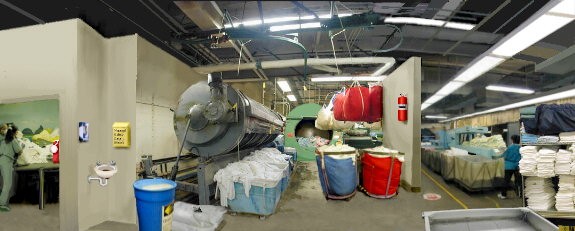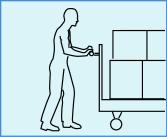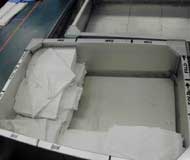
|
 |
Hospital eTool/Nursing Home eTool
Laundry Module
Click on the area for more specific information.

|
Common safety and health topics:
Contaminated Laundry as outlined in the Bloodborne Pathogen Standard definitions
Section (b) as: laundry which has been soiled with blood or other potentially infectious material or may contain sharps.
|
Potential Hazard
Exposure to blood or other potentially infectious materials through contaminated laundry that was improperly
labeled, or handled.
Possible Solutions
Follow the procedures outlined in the Bloodborne Pathogens Standard,
1910.1030(d)(4)(iv)
handling contaminated laundry such as:
|
-
Handle contaminated laundry as little as possible with minimal agitation.
|
|
- Bag contaminated laundry at the location of use. Do not sort or rinse laundry at the location where it was used
[1910.1030(d)(4)(iv)(A)(1)].
|
|
-
Place wet contaminated laundry in leak-proof, and color-coded or labeled containers, at the location where it was
used [1910.1030(d)(4)(iv)(A)(2)].
-
Whenever contaminated laundry is wet and presents a reasonable likelihood of soak-through of or leakage from the bag or container,
the laundry shall be placed and transported in bags or containers which prevent soak-through and/or leakage of fluids to the
exterior [1910.1030(d)(4)(iv)(A)(3)].
|
|
-
Contaminated laundry must be placed and transported in bags or containers labeled with the biohazard symbol or
put in red bags in accordance with
1910.1030(g)(1)(i).
-
In a facility that utilizes universal precautions in the handling of all soiled laundry-alternative labeling or color-coding
is sufficient if it permits all employees to recognize the containers as requiring compliance with universal precautions
[1910.1030(d)(4)(iv)(A)(2)].
- Use red bags or bags marked with the biohazard symbol, if the facility where items are laundered does not use
universal precautions for all laundry
[1910.1030(d)(4)(iv)(C)].
- For more information on labeling requirements see:
|
|
|
- Contaminated laundry bags should not be held close to the body or squeezed when transporting to avoid punctures from improperly
discarded syringes.
|

|
- Normal laundry cycles should be used according to the washer and detergent manufacturer's
recommendations.
|
|
|
Personal Protective Equipment (PPE)
|
Potential Hazard
Exposure to bloodborne pathogens through contact with contaminated laundry by not wearing appropriate PPE.
Possible Solutions
|
- Employers must ensure that employees who have contact with contaminated laundry wear appropriate PPE as discussed in the Bloodborne
Pathogens Standard
1910.1030(d)(4)(iv)(B)
when handling and/or sorting contaminated laundry.
|

|
- Employers must ensure employees wear appropriate PPE such as gloves, gowns, face shields, masks, when sorting contaminated laundry
[1910.1030(d)(4)(iv)(B)].
|
|
- The use of thick utility gloves when sorting contaminated laundry may provide workers with additional protection.
- Utility gloves may be decontaminated for re-use if the integrity of the glove is not compromised.
- However, they must be discarded if they are cracked, peeling, torn, punctured, exhibit other signs of deterioration, or when their
ability to function as a barrier is compromised
[1910.1030(d)(3)(ix)(C)].
|
|
- Disposable (single use gloves shall not be washed or decontaminated for re-use
[1910.1030(d)(3)(ix)(B)].
|
 For additional information, see HealthCare Wide Hazards -
PPE.
For additional information, see HealthCare Wide Hazards -
PPE.
|
|
|
Sharps Handling
|
Potential Hazard
Exposure to bloodborne pathogens from contaminated laundry that contains sharps.
Possible Solutions
A safety and health program that includes procedures for appropriate disposal and handling of sharps and follows
required practices outlined in the Bloodborne Pathogens Standard.
|
|
- Contaminated needles and sharps shall not be bent, recapped or removed. No shearing or breaking permitted
[1910.1030(d)(2)(vii)(A)].
|

|
- Sharps Containerization:
- Immediately or as soon as feasible, contaminated sharps need to be discarded in appropriate containers
[1901.1030(d)(4)(iii)(A)(1)].
-
Needle containers need to be available, and in close proximity to areas where needles may be found, including laundries
[1910.1030(d)(4)(iii)(A)(2)].
|
 For additional information, see HealthCare Wide Hazards -
Bloodborne Pathogens, and
Needle Stick Injuries.
For additional information, see HealthCare Wide Hazards -
Bloodborne Pathogens, and
Needle Stick Injuries.
|
 Hazardous Chemicals
Hazardous Chemicals
|
Potential Hazard
|
|
Employee exposure to hazardous cleaning chemicals found and used in the laundry or housekeeping process.
-
Unlabeled chemicals.
-
Splattering when pouring from larger container to smaller container.
-
Soaps and detergents may cause allergic reactions and dermatitis.
-
Broken skin from soap or detergent irritation may provide an avenue for infection or injury if exposed to chemical or biological hazards.
-
Never mix together cleaning solutions that contain ammonia and chlorine. When mixed together these chemicals form a deadly gas.
|
Possible Solutions

|
Implement a written program which meets the requirements of the
Hazard Communication Standard (HCS) to provide for worker training, warning labels, and access to Material
Safety Data Sheets (MSDS).
|

|
Medical Services and First Aid: Where the eyes or body of any person may be exposed
to injurious corrosive materials, provide suitable facilities for quick drenching or flushing the eyes and body within the work area
for immediate emergency use
[1910.151(c)].
|
 For additional information, see HealthCare Wide Hazards -
Hazardous Chemicals.
For additional information, see HealthCare Wide Hazards -
Hazardous Chemicals.
|
|
Latex Allergy
|
Potential Hazard

|
Exposure of worker to latex allergy from wearing latex gloves, while handling or sorting contaminated laundry.
|
Possible Solutions
Use appropriate gloves for latex-sensitive employees:
|
|
- Employers must provide appropriate gloves when exposure to blood or other potentially infectious materials (OPIM) exists
[1910.1030 Bloodborne Pathogens Standard].
|
|
- Alternatives shall be readily accessible to those employees who are allergic to the gloves normally provided
[1910.1030(d)(iii)].
|
 For additional information, see HealthCare Wide Hazards -
Latex Allergy, and
Pharmacy Module.
For additional information, see HealthCare Wide Hazards -
Latex Allergy, and
Pharmacy Module.
|
|
Noise Exposure
|
Potential Hazard
Occupational exposure to high noise levels from loud machinery in the laundry area can lead to
occupationally induced hearing loss, hearing impairment, hypertension, elevated blood pressure levels and other health
hazards.
|

Folding/Ironing Machine
|
Possible Solutions
A safety and health program that recognizes and addresses the hazards created by noise exposure.
 For additional information, see HealthCare Wide Hazards -
Noise.
For additional information, see HealthCare Wide Hazards -
Noise.
|
Exposure to excessive heat can result in heat exhaustion and heat stroke. At high temperatures, the body
circulates great amounts of blood to the skin in an effort to eliminate heat through perspiration. As a result, less blood is
circulated to the body's vital organs including the brain. Heat exhaustion can lead to dizziness, blurred vision, nausea, and eventual
collapse. If not treated promptly, by lowering the person's body temperature, a person suffering from heat exhaustion could suffer
brain damage.
Even more serious than heat exhaustion is heat stroke. During heat stroke the body stops sweating, making it
impossible to dissipate heat. The body temperature may rise to a dangerously high level in a short time and cause death.
|
Potential Hazard
Workers may be exposed to excessive heat from working in laundry areas. Exposure to excessive heat may lead to heat exhaustion, heat
stroke, and possible death.
Possible Solutions
Good work practice includes educating and training employees and supervisors to detect early signs of heat-related
illness and have available first aid workers to recognize and treat these illnesses.
-
Recognize the first signs of heat exhaustion, (e.g., dizziness, lightheadedness, weakness, blurred vision,
nausea) and take immediate action to lower the employee's body temperature to prevent the progression of symptoms. Workers suffering
from heat exhaustion should be removed from the hot environment and immediately given cool water to drink. Lay them on their back and
raise their legs. If they are sick to their stomach lay them on their side. If the person does not feel better in a few minutes call
for emergency help.
-
Recognize the signs of heat stroke (which can be fatal). The symptoms are severe headache, mental confusion,
loss of consciousness, flushed face, and hot, dry skin, with no sweating. If someone has stopped sweating, seek medical attention
immediately. If a worker shows signs of possible heat stroke, professional medical treatment should be obtained immediately.
- The worker should be placed in a cooler, well ventilated area and the outer clothing should be removed. The worker's skin should be
wet and air movement around the worker should be increased to improve evaporative cooling until professional methods of cooling are
initiated and the seriousness of the condition can be assessed. Fluids should be replaced as soon as possible. The medical outcome of
an episode of heat stroke depends on the victim's physical fitness and the timing and effectiveness of first aid and medical treatment.
Good work practice encourages employers to assess worksites for potential hot work
environments and identify and address ways to decrease heat hazards in these areas.
Employers should be aware of engineering and work practice controls such as:
- General ventilation and local exhaust ventilation at points of high heat production.
- Spot cooling fans.
- Shielding from radiant heat.
- Evaporative cooling and air conditioning.
- Protective clothing and equipment.
- Provide plenty of drinking water.
- Acclimatize, or gradually introduce employees to the hot environment, because the body gradually builds up a tolerance to high
temperatures. This process usually takes up to 2 weeks.
- Encourage employees to perform the heaviest work in the coolest part of the day.
- Encourage employees to wear light, loose-fitting, breathable (like cotton) clothing.
- Consider the employee's physical condition and recognize that older or obese workers and personnel on some types of medication are
at greater risk.
- Understand the danger of using drugs, including therapeutic ones, and alcohol in hot work environments.
- Encourage employees to avoid using caffeine and alcoholic beverages while working in hot environments. These beverages make the
body lose water and increase the risk for heat illnesses.
- Alternate work and rest periods. Encourage frequent short breaks in cool areas to allow your body to cool down.
- Monitor temperatures, humidity and workers' responses to heat at least hourly.
- Supervisors should be able to detect early signs of heat-related illness and permit workers to interrupt their work if they are
extremely uncomfortable.
- Educate employees to recognize the need to replace fluids and salt lost through perspiration.
Additional Information:
|
 Lifting/Pushing Hazards
Lifting/Pushing Hazards
|
Potential Hazard
Excessive reaching/pushing and/or lifting wet heavy laundry can cause work related
musculoskeletal disorders
such as strains and sprains to the back or shoulder area.
Possible Solutions
Assess the laundry area for ergonomic stressors and identify and address ways to decrease stressors such as:
|
|
- Use proper lifting techniques:
- Avoid lifting bulky or awkwardly weighted objects.
- Avoid lifting/reaching or working above shoulder height.
- Avoid awkward postures, such as twisting while lifting.
- Lift items close to the body.
- Limit the weight of the item to be lifted.
|
|
|
- Use well maintained carts with large, low rolling, low resistance wheels, that can roll easily over mixed flooring as well as gaps
between elevators and hallways.
|

Well Maintained Cart
|

|
- Use mechanical aids to reduce the need to lift, such as:
|

Spring-loaded Platform
|
|
|
- Washers that automatically dump their loads into baskets so workers don't have to reach in and pull out wet heavy laundry manually.
|

Automatic Dumping Washer
|
 For additional information, see HealthCare Wide Hazards -
Ergonomics.
For additional information, see HealthCare Wide Hazards -
Ergonomics.
|
|
 Fire Hazards
Fire Hazards
|
Potential Hazard
Increased fire hazard because of lint build-up on ceilings and other surfaces such as heat producing equipment.
Lint build-up in lint traps can also be a hazard.
Possible Solutions

|
Routine cleaning surfaces of lint, and emptying of lint traps.
- "Housekeeping." The employer shall control accumulations of flammable and combustible waste materials and residues so
that they do not contribute to a fire emergency. The housekeeping procedures shall be included in the written
fire prevention plan [1910.38(b)(3)].
|
|
- The employer shall apprise employees of the fire hazards of the materials and processes to which they are exposed
[1910.38(b)(4)(i)].
- The employer shall review with each employee upon initial assignment those parts of the fire prevention plan which the employee
must know to protect the employee in the event of an emergency
[1910.38(b)(4)(ii)].
|
|
- "Maintenance." The employer shall regularly and properly maintain, according to established procedures, equipment and
systems installed on heat producing equipment to prevent accidental ignition of combustible materials. The maintenance procedures
shall be included in the written fire prevention plan
[1910.38(b)(5)].
|
 For additional information, see HealthCare Wide Hazards -
Fire Hazards.
For additional information, see HealthCare Wide Hazards -
Fire Hazards.
|
|
Slip/Trips/Falls
|
Potential Hazard
Employee exposure to slips/trips/falls from the wet floors found in the laundry area.
|

|
Possible Solutions
A safety and health program that recognizes and addresses slip/trips/falls hazards.
 For additional information, see HealthCare Wide Hazards -
Slips/Trips/Falls.
For additional information, see HealthCare Wide Hazards -
Slips/Trips/Falls.
|
|

